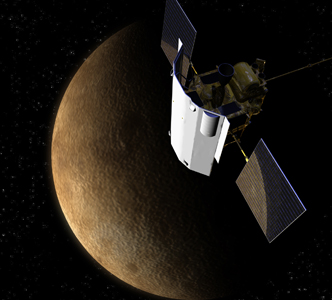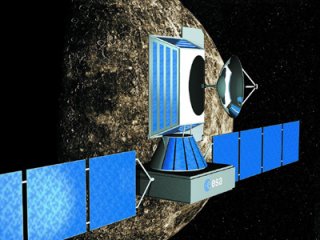Mariner 10
The first probe sent to Mercury was a U.S. spacecraft: Mariner 10. It made three flybys of Mercury in March 1974, September 1974 and March 1975. The first flyby has allowed discovering that Mercury, contrary to what was thought, had a magnetic field and an atmosphere. The low density of the crust of the planet was also observed and the pictures revealed a surface covered with craters. The second flyby allowed mapping 45% of the planet's surface. The last flyby revealed that the magnetic field was not only due to solar winds, the mechanism that creates this field is one of the questions that the probes BepiColombo and Messenger will try to elucidate. Mariner 10 has significantly advanced our knowledge on Mercury by answering some of our questions, but also, by raising new ones.

|
Messenger
(MErcury Surface, Space ENvironment, Geochemistry, and Ranging) is the second spacecraft launched to Mercury, on the third of August 2004. This is a NASA mission. It will fly once by the Earth, twice by Venus and three times by Mercury. Then, in March 2011, it will be the first spacecraft in orbit around Mercury, after six and a half years of travel.
|
|
The Messenger probe
(credit: JPL/NASA)
|
This mission aims to answer the following questions:
- What is the geological history of Mercury ?
- Why is Mercury so dense ?
- What is the structure of Mercury's core ?
- What is the nature of the magnetic field of Mercury ?
- What do the poles of Mercury consist of ?
- Why volatiles, which constitute the thin layer of gas surrounding the planet, are so important on Mercury ?
To answer these questions, the spacecraft carries eight instruments:
- Mercury Dual Imaging System MDIS: two cameras, wide angle and small-angle, whose role will be to map the topography and terrain of the surface of Mercury.
- Gamma-Ray and Neutron Spectrometer GRNS : this spectrometer will detect gamma rays and neutrons. It will be used to map the relative abundance of certain elements on Mercury and determine whether the poles, which are never directly exposed to the Sun, do or do not contain ice.
- X-ray Spectrometer XRS: this spectrometer will detect X-rays from the Sun, and analyze how they interact with the surface of Mercury, completing the analysis by the GRNS.
- Magnetometer MAG: this magnetometer will map Mercury's magnetic field and look for magnetic rocks on the crust.
- Mercury Laser Altimeter MLA: a laser altimeter that will send a ray to Mercury and measure the time it takes for this ray to reach the ground and return to the instrument. Recording of the variations in these measurements will allow to know the precise topography of Mercury.
- Mercury Atmospheric and Surface Composition Spectrometer MASCS: this spectrometer is sensitive to light ranging from infrared to ultraviolet; it will measure the abundance of atmospheric gases and detect minerals on the surface of Mercury.
- EEnergetic Particle and Plasma Spectrometer EPPS: this spectrometer will measure the composition, distribution and energy of charged particles in the magnetosphere of Mercury.
- Radio Science RS: this instrument uses the Doppler effect on the radio signal to measure very small changes in the speed of the probe in orbit around Mercury. These data will allow to study the mass distribution of Mercury and the variations in the thickness of the crust.
In order to view the official website of the NASA MESSENGER :
click here.
BepiColombo
BepiColombo is a mission of ESA (European Space Agency) to Mercury in collaboration with ISAS (Japan). Its departure is scheduled for 2014. Six years later, in 2020, BepiColombo will split into two probes: the Japanese one (Mercury Magnetospheric Orbiter MMO) and the European one (Mercury Planetary Orbiter MPO). Both will be in orbit around Mercury and withstand temperatures up to 350 °C. BepiColombo is named after Professor Giuseppe Colombo (1920-1984), nicknamed Bepi, an Italian mathematician and engineer who was the first to suggest that Mercury had a
resonance 3/2.

|
The mission objective is to answer the following questions:
- What can we learn from Mercury on the composition of the solar nebula and on the formation of the solar system ?
- Why is the density of Mercury so high ?
- How is the "unknown face" of Mercury ?
- Is the core of Mercury liquid or solid ?
- Does Mercury have a tectonic activity today ?
|
The BepiColombo probe
(credit:ESA) |
- Why does such a small planet have an intrinsic magnetic field, while Venus, Mars and the Moon have not ?
- What is the origin of this magnetic field ?
- Why do spectroscopic observations not reveal the presence of iron when this element is assumed to be the major constituent of Mercury ?
- How did Mercury evolve geologically ?
- Do the craters of the polar regions, constantly in the shadow, contain sulfur or water ice ?
- What are the mechanisms of formation of the exosphere ?
- In the absence of ionosphere, how does the magnetic field interact with the solar wind ?
- The progress of the perihelion of Mercury is explained by the curvature of space-time. The proximity of the Sun can thus be used to test general relativity with greater precision.
To obtain the answers to these questions, the following instruments will be aboard Mercury Planetary Orbiter :
- Bepi Laser Altimeter BELA: BELA will measure the time the signal will take to make a round trip between the probe and the surface of Mercury. A transmitter will issue light pulses and a collector (telescope and receiver) receives the signal reflected from the surface of Mercury. An electronic system will provide the emission and the detection of pulses, measure the time of flight and control everything. The instrument will always point to the center of mass of the planet. Thanks to BELA, the topography of Mercury's surface will be known with an accuracy of 1 meter.
- Italian Spring Accelerometer ISA: the accelerometer will measure the non-gravitational accelerations of the probe. By analyzing the trajectory of the probe, it will allow to obtain the gravitational acceleration (to separate the parties and non-gravitational gravitational acceleration felt by the probe).
- Spectrometers and Imagers for MPO BepiColombo Integrated Observatory System SYS-SIMBIO: these infra-red spectrometers and stereo high-resolution cameras will map the global mineralogy.
- Mercury Orbiter Radio science Experiment MORE: The objective of MORE is de determination of the gravity field of the planet, its rotation, its dimension, the physical state of its core, and to provide information on the internal structure of Mercury. A radio signal is sent from Earth, will be received by the probe and returned to Earth where we measure the time taken to complete the round-trip and the effect on the frequency due to the velocity of the probe relative to the Earth (Doppler effect). As the solar wind distorts the signals, two waves of different frequencies are sent in order to calculate and remove the effect of solar wind on the signal.
-
Through these measures, we can first reconstruct the trajectory of the probe and thanks to ISA, which measures non-gravitational accelerations of the probe, we refine our knowledge of Mercury's gravitational field.
- Measurements of deviations of the trajectory of the probe on top of geological formations or craters will allow, in combination with data from the altimeter BELA, to reconstruct the mass anomalies on the surface and below the surface of Mercury.
- Moreover, using SIMBIO-SYS, we can observe the movements of Mercury in space and reconstruct its libration. Indeed, for the first time the camera will move compared to the surrounding stars. Then, when the probe will pass over a particularly area (a target), it will take a photo. Measurements made by MORE from Earth will then be used to locate the spacecraft in space. These steps will be repeated over time, what allows comparing the photos and getting with great accuracy the positions of targets in space and at different times. Deviations from the position of the observed area when considering uniform rotation of Mercury will provide its libration. One will then be able to obtain information on the interior of Mercury through the formula of Peale.
- The deviations of the signal path caused by the Sun will be analyzed for more information on the parameters of general relativity.
Click here to visualise the MORE experiment.
- Mercury Magnetometer MERMAG: this magnetometer will measure the magnetic field of Mercury and will deduce its source and its interactions with the solar wind.
- Mercury Thermal Infrared Spectrometer MERTES-TIS: this instrument contains a radiometer and a thermal imaging spectrometer ; it will measure the surface temperature and the thermal inertia to the global mineralogical mapping.
- Mercury Gamma ray and Neutron Spectrometer MGNS: these gamma and neutron spectrometers and neutron will measure the elemental composition of the surface, sub-surface and the composition of volatile deposits in polar regions.
- Mercury Imaging X-ray Spectrometer MIXIS: the Imaging Spectrometer X-rays will determine the composition of Mercury's surface and map the amount of chemical elements.
- Probing of Hermean exosphere by Ultraviolet Spectroscopy PHEBUS: this far and extreme ultraviolet spectrometer will make a spectral UV mapping of the exosphere of Mercury.
- Search for Exosphère Refilling and Emitted Neutral Abundances SERENA: these mass spectrometers and neutral particle analyzer will study the composition of the vertical structure of the source and deposition process in the exosphere..
- Solar Intensity X-ray Spectrometer SIXS: this spectrometer will monitor the intensity of solar X-rays and solar particles to complement measures of the MIXS instrument.
The Royal Observatory of Belgium is involved in the instruments BELA, SYS-SIMBIO and MORE. In particular, the Observatory will focus on the rotation and the internal structure of Mercury.
The Japanese probe MMO will examine the magnetosphere of Mercury and its interaction with the solar wind.
The instruments on board are:
- PWI Plasma Wave Instrument: PWI is composed of several instruments that study the structure and dynamics of the magnetosphere of Mercury.
- Mercury Magnetometer MERMAG-M/MGF: these magnetometers will measure Mercury's magnetic field.
- Mercury Plasma Particle Experiment MPPE: MPPE contains several different instruments to study the high and low energy particles of the magnetosphere of Mercury.
- Mercury Sodium Atmospheric Spectral Image MSAS: This spectrometer will work on the characterization of the exosphere of Mercury.
- Mercury Dust Monitor MDM: MDM measure the distribution of dust in the orbit of Mercury.
Click here to view the official website of the ESA BepiColombo.

